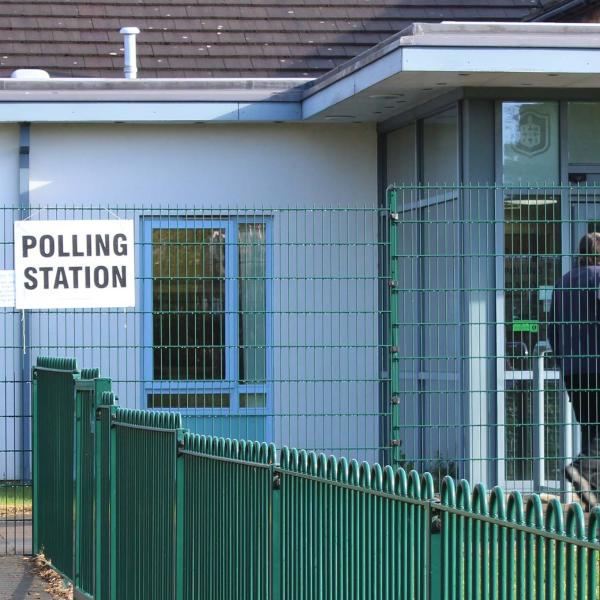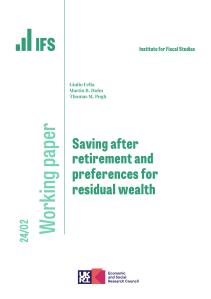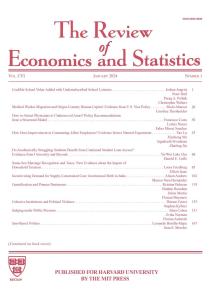Executive summary
Pensions are the biggest component of household wealth and are treated favourably by the tax system. That means getting pensions tax design right matters. It matters for people’s well-being in retirement, especially if it can support the pension saving of those at risk of undersaving for their retirement. It also matters for taxpayers. Overly generous tax subsidies will be expensive, while insufficient generosity could lead to undersaving placing upwards pressure on state support for pensioners in the future.
The context
The UK pension system provides individuals with significant flexibility over how much, and in what form, to save for retirement. This has many advantages. But there are concerns about the adequacy of retirement incomes among private sector workers. Automatic enrolment has been successful in bringing large numbers of employees into pensions: prior to its introduction, fewer than half of employees were members of a workplace pension, with the proportion falling over time. Around eight-in-ten employees are now members of such schemes, and closer to nine-in-ten among those in the automatic enrolment target group. But many are contributing relatively small amounts.
Levels of saving vary substantially across groups:
- Of the 28% of employees who are members of a defined benefit pension (mostly in the public sector), 87% receive an employer contribution worth 12% of salary or more.
- Of the 51% of employees who are members of a defined contribution pension (mostly in the private sector), however, just 9% receive an employer contribution worth 12% of salary or more.
- Nor is it just private sector employees who risk undersaving for retirement. Of the 5 million self-employed in 2018 just 16% were contributing to a pension – a remarkable fall from the 48% twenty years earlier, with no evidence that the self-employed have become more likely to save in other forms.
Related to the well-publicised shift in the private sector away from defined benefit pensions to less-generous defined contribution pensions, the rates of return to a range of different assets have declined over time. This means that wealth accumulation has been, and could continue to be, more challenging for younger generations than it was for their predecessors. Those born in the 1960s or later are no longer experiencing substantial generation-on-generation wealth increases. Older generations have benefited from capital gains on housing and from generous defined benefit pension arrangements in a way that younger generations are much less likely to. In turn, this raises the question of whether the tax system treats different generations fairly, and whether a better way of taxing pensions is needed. In short: it is.
Principles
Any savings vehicle involves three main flows of funds that can potentially be subject to tax: contributions made, returns that accrue, and withdrawals. It is the combination of all three – the treatment of contributions, returns and withdrawals – that will determine how much support is being provided and to whom. In general, the tax system should be neutral – that is, it should treat similar things in similar ways. That is not to say there is not a role for the tax system to incentivise pension saving. But these incentives should be well targeted towards meeting clear objectives, such as supporting the saving of those who would otherwise be most at risk of undersaving for retirement, and minimise other distortions to behaviour and inequities.
Where individuals save in a deposit account, contributions are made out of after-tax income, returns are subject to income tax (above a substantial allowance) and withdrawals are untaxed. This is known as a taxed-taxed-exempt (TTE) regime. In general, this is not a good way to tax saving: for example, it means that even returns that are only compensating for inflation can be subject to tax and encourages spending now rather than saving for spending later. But most saving in the UK outside pensions is done in the form of ISAs and owner-occupied housing, both of which are (broadly) subject to a taxed-exempt-exempt (TEE) regime. And the income tax treatment of pensions is actually closest to an exempt-exempt-taxed (EET) regime – that is, one where contributions are made free of tax but withdrawals are taxed.
Where an individual’s tax rate does not vary over time, and where everyone gets the same (‘normal’) rate of return on their investments, there is no difference between the overall generosity of a TEE system and that of an EET system. The only difference is in the timing of when the tax is paid. Those whose income tax rate is lower in retirement than when saving will, all else equal, do better under an EET regime. It allows such individuals to benefit from shifting their taxable income to later periods of life, which might be seen as fair and desirable, though the point is certainly debated. An advantage of an EET system is that where bigger investment returns are enjoyed, the spoils are shared between the individual and the Treasury; in contrast, under a TEE system, individuals who get bigger returns keep all of the benefit from them.
Any reform to pensions tax should be seen in the wider context of the UK tax system. Some of the most important features of the current system rely on discounts or exemptions from income tax or National Insurance contributions (NICs). The result is that when changes are made to these taxes, the generosity of the tax treatment of pensions changes too, even if this was not intended by policymakers. Equally, where pensions tax reforms are proposed in order to help meet a specific distributional objective – for example, a desire to redistribute away from those on higher incomes – it could be that other changes, such as reducing the higher-rate threshold in income tax, would be more straightforward.
Other desirable features of a pensions tax system include simplicity and stability over time, as both should help enable individuals to respond to the incentives provided and to plan appropriately for the long term.
When implementing reforms, careful consideration needs to be given to how they should be phased in so that they do not distort behaviour inappropriately. And while reforms that change the tax that people might reasonably have expected to pay are never ideal, it should be remembered that some retrospection will often be impossible to avoid without extremely long transitions, and that this applies across all sorts of tax changes, not just taxes directly levied on savings and wealth. Retrospection is not binary; it comes in different types and degrees, and there are choices to be made as to what is acceptable in different circumstances. Where a reform is removing an overly generous tax relief, there will be a trade-off between a retrospective change and allowing the overly generous element to remain in place for longer, typically to the benefit of older generations at the expense of subsequent generations.
In determining the extent to which retrospective tax rises are appropriate, it should be remembered that some have enjoyed windfall gains from policy changes: for example, a 30-year-old who saved in a pension in the early 1990s might have done so in the expectation of paying income tax in retirement at 25%, as this was the basic rate in place at the time. Now aged around 60, they could be paying basic-rate income tax at the now lower rate of 20% on their pension income. Given this, and a context where, remarkably, pensioner incomes are now, on average, in line with those of the working-age population, there is surely a case for any reductions in generosity to apply, at least partially, to all generations.
Support under the current system
The current income tax treatment of pensions is most similar to an EET system. But in terms of how the whole tax system works, the taxation of pensions differs from a pure EET regime in a number of respects including:
- Up to one-quarter of an accumulated pension can be withdrawn free of income tax and therefore does not attract income tax either on contributions or on withdrawals.
- Individuals’ pension contributions are made out of income that has been subject to NICs, but no NICs are charged on pension income (a TEE regime).
- Employer pension contributions, however, do not incur employer or employee NICs at any point and are therefore especially tax-advantaged (effectively EEE as far as NICs are concerned).
- Pension pots that remain at death are not counted as part of the estate for inheritance tax purposes, and for those who die before age 75 these funds escape income tax entirely.
- There are lifetime and annual limits on the amount that can be saved free of income tax in a pension.
We attempt to quantify the difference in the lifetime tax burden on contributions made in a single year under the current system compared with a TEE system and with an EET system, both of which could be considered reasonable benchmarks. Relative to the former, the current system is, according to our model, more generous to the tune of around £46 billion a year in today’s terms (adjusting for risk in future revenue). This is largely due to the fact that far more people face a higher income tax rate in working life, compared with the average rate they pay on their pension income in retirement, than vice versa. This means that levying income tax on pensions in retirement will, all else equal, mean a lower lifetime tax burden than taxing them in working life. In terms of the distribution of this support, we estimate that, on average, relative to TEE, the current system benefits all earnings groups, with the gains increasing (as a percentage of earnings) as one moves up the earnings distribution.
In contrast, we estimate that, relative to an EET benchmark, the current system is more generous to the tune of £4.4 billion a year (risk-adjusted). The gains under the current system come in large part from the fact that 25% of pension withdrawals can be made free of income tax and that employers’ contributions to pensions escape NICs entirely. Conversely, lower and middle earners making individual pension contributions receive harsher NICs treatment than they would under the EET benchmark as the latter would give them up-front NICs relief on their contributions and they would pay little or no NICs if they were applied to pension withdrawals. Overall, we estimate that the gains from the current system relative to an EET benchmark are focused towards the top of the earnings distribution with those in the middle of the earnings distribution actually being slightly worse off under the current system relative to EET.
It should be noted, however, that this modelling excludes the generous tax treatment of pensions at death and also the limits on how much can be contributed to, or accumulated in, a tax-favoured pension.
Reasons to retain up-front income tax relief
It is often proposed that up-front income tax relief should be reformed: for example, by restricting it to the basic rate of income tax, or by having a flat rate of up-front relief – perhaps of 30% – available to all. Often such proposals are made on the basis that up-front income tax relief disproportionately goes to those on higher incomes. HMRC statistics show that in 2020–21 52% of up-front income tax relief was given at the higher rate and 6% at the additional rate, whereas only 13% of income tax payers were higher-rate taxpayers and just 1.4% were additional-rate taxpayers. These figures do not include the fact that up-front employee NICs relief is of relatively less value to higher earners, and that higher earners will typically pay more income tax on their pension income. Nevertheless, relative to a system with no tax relief, higher earners do gain much more from the current system than lower earners.
That said, if one is going to have any system of tax relief for savings then it is always going to be the case that higher earners will gain the most. After all, they pay far more tax: 73% of income tax is paid by higher- and additional-rate payers, much more than the proportion of pensions tax relief that they benefit from.
One might not want to limit up-front relief in any case. To do so would mean that those with high incomes in working life and low incomes when retired would pay more tax than individuals with the same income over their life but more evenly spread out. Up-front relief allows people to smooth their taxable income across years, which avoids this inequity. The attractiveness of facilitating tax-base smoothing is not entirely clear-cut because some are not able to take advantage of it. Given this, both the current system and one that limited the rate of up-front relief would exhibit some inequities and there is room for reasonable disagreement on the best way forward. But note that the (far larger) group who receive basic-rate income tax relief on contributions and pay no income tax on their pension income are also benefiting from tax-base smoothing. If it is considered ‘unfair’ to get higher-rate relief and then pay only basic-rate tax in retirement, it would seem equally ‘unfair’ to get basic-rate relief and then pay no tax in retirement – yet would-be reformers seem unconcerned by the latter. The logical conclusion if one wishes to prevent tax-base smoothing would be to have flat-rate relief on contributions and flat-rate tax on withdrawals. If the goal is not that, but simply to raise taxes from individuals with high incomes, increasing rates and reducing thresholds of income tax would achieve this aim without reducing people’s ability to smooth their taxable income.
For those who believe that limiting up-front relief would be an improvement on the current system, there is a crucial practical issue of how employer contributions to defined benefit arrangements could be accurately attributed to specific individuals in order to be taxed. This is genuinely hard. Contributions could be made by an employer to fill a pension deficit created by retired members living longer than expected. One would not want to tax current members for that. On the other hand, not taxing this contribution would create a bizarre incentive to try to underfund pensions. In addition, the pension contribution made in respect of new accrual among active members might be more valuable to some than others – for example, because they are closer to drawing their pension, or because they expect to live for longer or, in a final salary arrangement, because they expect a big future promotion. With half of up-front income tax relief going to those in defined benefit arrangements, getting this attribution right would be extremely important, and far from easy, to do well.
While we do not recommend reforms to up-front income tax relief, we show that restricting relief to the basic rate of income tax would in the long run represent a £15 billion a year increase in taxation, with almost all of this increase coming from the top 20% of earners. We also show that imposing a 30% flat rate of up-front income tax relief – a £3 billion long-run tax rise – would redistribute the burden of taxation from the bottom 80% to the top 20% of earners.
Reform package proposed
We propose a package of specific measures that would, at least, reduce the problems we have identified with the current system.
- The 25% tax-free component needs reform. It currently provides an additional tax subsidy to those who have already accumulated big pensions, provides a more generous rate of subsidy to those who are higher-rate taxpayers in retirement than to those who are basic-rate taxpayers and is of no value at all to those who have the lowest incomes in retirement: non-taxpayers. This is hard to justify. At the very least it should be capped so that it only applies to 25% of, say, the first £400,000 of accumulated pension wealth. Going further, we propose providing the equivalent of a capped 25% tax-free component for basic-rate taxpayers, but designed in a way that increases the after-tax value of everyone’s pension (up to the cap) by the same proportion – basic-rate, higher-rate and non-taxpayers alike. A 6¼% taxable top-up on all pension withdrawals would achieve this. There would be a case for providing a bigger top-up on withdrawals made via an annuity (which provides a secure retirement income) and a smaller one for other withdrawals.
- The EEE employee NICs treatment of employer pension contributions should be ended. We propose that all individual pension contributions should receive up-front relief equivalent to the rate of employee NICs and, in return, we should gradually move to a system where pension withdrawals are subject to employee NICs. This EET approach would align the employee NICs treatment of pension saving with that of income tax. For employer pension contributions it would represent a clear reduction in the generosity of tax treatment, moving from full exemption (EEE) to taxation at withdrawal (EET). For individual pension contributions the change would be one of timing, moving from a TEE to an EET approach. Because the employee NICs rate falls from 12% to 2% at the upper earnings limit, this treatment would benefit low and middle earners who make individual contributions (who would get up-front relief at 12% and would typically have only part of their pension income above the NICs threshold in retirement) relative to higher earners who make individual contributions (who would get up-front relief at just 2% but would often pay an average rate of NICs far above that in retirement).
- The EEE employer NICs treatment of employer pension contributions should also be ended. We recommend applying employer NICs to all employer pension contributions alongside introducing a new subsidy on all employer pension contributions. Employer NICs would be levied on pension contributions on a TEE basis, with the largely flat-rate structure of employer NICs meaning this is practical for defined benefit and defined contribution arrangements alike. This change would end the current state of affairs whereby the effective subsidy on pension contributions is arbitrarily altered whenever the employer NICs rate changes and ensure a uniform incentive for all employers, including those not currently liable for employer NICs (such as small employers) for whom the current NICs exemption is worthless. Policymakers would be forced to determine actively the right rate of subsidy and, once it was in place, would be free to adjust it independently of the NICs rate. Below we model a subsidy set at 13.8% – the current main rate of employers NICs – which would mean no employer would immediately lose out from the reform.
We estimate the revenue effects of these reforms. For policies that apply to future pension income (where it is necessary to make an assumption about the value of risky future pension incomes in today’s terms), we estimate the risk-adjusted present value of tax payments. Our modelling suggests that implementing these reforms would be close to revenue-neutral in the long run, although there is a lot of uncertainty around this estimate. If pension returns turn out to be strong (as they have been in the past), more (and possibly substantially more) revenue would be raised from policies that increase taxes on those future returns.
Providing any transitional protection from the application of employee NICs to pension withdrawals would reduce revenue in the near term. The up-front cost of the package would be £3.3 billion, less any revenue raised from imposing NICs on the pension income of those currently drawing pensions (which would raise around £¾ billion for every 1 percentage point of NICs charged).
The government could easily adjust how much revenue was raised overall by adjusting the proposed new subsidy on all employer pension contributions (for example, a rate of 10% rather than the 13.8% we assume in our modelling would save around £3½ billion a year immediately) or the size of (or cap on) the income tax top-up on withdrawals, and there are two other tax measures that we set out below that could raise revenue.
The estimated long-run distributional impact of these three reforms among current workers is shown in Figure ES.1. Overall, the bottom eight deciles of earners would (in the long run) gain from these reforms – and see their incentives to save in a pension strengthened – while the top two deciles would lose and see their incentives weakened. Low and middle earners, who fare worst under the current system relative to an EET benchmark, would gain because up-front employee NICs relief is worth more to them than the cost of having to pay employee NICs on pension withdrawals (even though employee NICs would apply to pensions generated by employer contributions – which are currently fully exempt – as well as employee contributions) and because our reforms extend the equivalent of basic-rate relief on 25% of pension withdrawals to those who do not pay tax in retirement. The losses among higher earners – who currently fare best relative to an EET benchmark – are driven primarily by the change to employee NICs. Excluded from the modelling is any cap on the replacement of the 25% tax-free element which, as well as reducing the overall cost of the package, would also slightly increase the losses at the top of the distribution.
Figure ES.1. Impact on working-age earners of implementing the key income tax and NICs changes from our proposed pensions tax reform package

Note and source: See Figure 7.7.
There would need to be a careful transition towards this long-run position. Specifically, where reforms would affect how already-accumulated pension wealth would be treated on withdrawal, there would be a trade-off between implementing a better system more swiftly and taxing some more heavily than they might have anticipated when they made the decision to save in a pension.
Some further reforms should be introduced alongside the three measures set out above. As set out in our recent report, Death and Taxes and Pensions, the tax system is currently more generous for the use of pensions as a vehicle for bequests than as a vehicle for providing a retirement income. This bizarre situation arises for two reasons. First, when an individual dies before age 75, funds that remain in a pension escape income tax entirely. Instead, we propose income tax should apply on withdrawals from inherited pensions regardless of the age of death. Second, in all cases, pension pots at death are typically not counted as part of the deceased’s estate for inheritance tax purposes. We propose that if we are to have an inheritance tax, it should apply to all forms of wealth and therefore pension pots should be included in estates. Together, these measures would raise additional revenue, with the inheritance tax change in particular falling predominantly on wealthier individuals and their heirs. If the government did not want to increase inheritance tax overall, it could use the revenue raised from that measure to reduce the inheritance tax rate or increase the threshold.
The lifetime and annual limits on the amount that can be saved free of income tax in a pension have been cut sharply since 2011, raising taxes by an estimated £8 billion a year. Implementing the reforms set out above would allow policymakers to be more relaxed about these limits. We therefore propose that, as part of this package of reforms, pension limits should be redesigned, with distinct approaches for defined benefit and defined contribution arrangements (although with an eye to making them of roughly equivalent generosity). For defined benefit arrangements, it would make sense to use regulation to place a cap on the pension benefits. For defined contribution arrangements, we propose replacing the current lifetime allowance with a lifetime contribution cap. This would have the advantage of not distorting the investment decisions of those with large pension pots. This restructuring of lifetime limits could be coupled with an increase in their generosity. There is an even stronger case for a substantial increase in the annual allowance, and in particular the policy of tapering the annual allowance for very high earners should be ended. This would have the benefit of equalising incentives to save across extremely high and merely very high earners.
Conclusion
Taken together, the package of changes we propose would, once fully in place, boost the retirement incomes of low and middle earners and provide greater encouragement for them to save more in a pension. It would also reduce some of the overly generous tax subsidies provided to those groups who are not in danger of undersaving for retirement, such as those who already have large pension pots and high earners receiving large employer pension contributions. This evening-out of tax support for pension saving would be more equitable and more economically efficient, and would allow the current set of poorly designed limits on what individuals can save in a pension to be relaxed.
Crucially, the new parameters in our proposed system – in particular, the rate of subsidy on employer contributions and the rate of taxable top-up on pension withdrawals – would be decoupled from rates of NICs and income tax. This would leave policymakers with a free hand to make explicit and transparent decisions about how generous they wish the system of pensions taxation to be and how much to subsidise employer versus employee pension contributions – a marked improvement on the current opaque and unwieldy arrangement whereby this generosity is a function of the income tax and NICs rates an individual and their employer happen to face.
The current system of pensions taxation has too many features that are arbitrary, wasteful or unfair. It is long past time we retired them.














